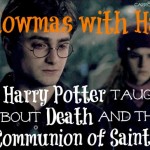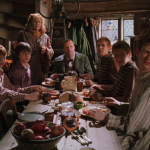Welcome to Carrots! I'm so glad you're here. This is where I share thoughts on liturgical living, faith, parenting, culture, and an extra dose of Jane Austen. You can sign up for my email newsletter here to stay in touch, or look me up on Instagram!

From middle school through college I eagerly anticipated each new HP book release but I don’t think I could have even articulated what drew me in. Looking back, it was more than compelling plots and endearing characters. What I found alluring was the magical world Rowling created. A world full of traditions that brought people together into a strong community where you belonged.
I recently saw some great insights on the richness of Hogwarts traditions being a muted reflection of the the liturgical year in a post about why Rowling’s Harry Potter series was so successful. I had never thought about that, but the comparison immediately hit home for me.
When I was first introduced to the idea of the Christian Year–full of traditions, seasons, and feasts–I was enchanted. The beauty of the rhythms of the liturgical year leading us to walk with Christ through all the seasons of the calendar. The richness of the cultural and food traditions handed down by other Christians all over the world. It was like getting my Hogwarts letter, except I was being invited into Christian tradition, not a school of wizardry.
I fell in love with Advent, Christmastide, Epiphany, Lent, and Eastertide. I was participating in something huge and splendid.
Celebrating the Christian Year roots us to a community and because our culture has lost those traditions even in Catholic homes. I think that’s why the liturgical year is making a comeback in Catholic life and beyond. We are hungry for that connection. And I mean that literally. Food culture and traditions are such a rich part of the human experience.
Thanksgiving at my house just isn’t Thanksgiving without Au Gratin Potatoes and my great grandmother’s Chocolate Creme Pie recipe. And it’s just not the Feast of St. Michael without a roast goose. Okay okay, you got me. NOT everyone has a roast goose on September 29th. In fact, almost nobody does. But it used to be a tradition in certain parts of Christendom just like Treacle Tart and Pumpkin Pasties are a must for the Halloween feast at Hogwarts.
Things would have gone like this:
Old Timey Guy #1: What are you having for dinner tonight?
Old Timey Guy #2: Roast Goose, of course! It’s Michaelmas, you fool!
Old Timey Guy #1: By George! I better pick the blackberries before the devil spits on them!
(Liturgical year nerd points if that was funny to you. And tangent: We are totally roasting a goose this year. Get ready.)
I think we deeply miss these traditions that bring us together and root us in community. That’s why we love Hogwarts so much. Who doesn’t want to be part of a house with traditions and history and belong somewhere?
Part of what makes the liturgical year and the Hogwartsian traditions so compelling to us is that our culture has slowly lost community celebration to commercialization. And even though we still have “holidays” they motivate us to spend more than bring us together. We have Christmas. (Buy presents.) Valentine’s Day. (Buy flowers and chocolates). And so it goes.
I think this lack of rich tradition is why we’re so drawn to the magical academic calendar of centuries-old Hogwarts. And it’s why the Christian Year can enchant us by giving us a common language to share with those half a world away and generations back.
I’m never going to see the Headless Hunt or the Hogwarts feast for Halloween. But I can observe Hallowmas on All Hallows Eve by preparing for the Feast of All Saints (All Hallows) on November 1st and then the Feast of All Souls on November 2nd. We have such a rich liturgical history and there is so much beauty. When we light our Advent candles each year and sing an ancient Advent hymn, it takes my breath away.
The Christian Year connects me to something so big and beautiful. Christians all over the world and saints in heaven. Consider this your letter of invitation, even if it didn’t arrive by owl.






I love this connection between the liturgical year and Hogwarts, Haley. I think so many people can relate to this feeling.
Glad I’m not the only one that wants to live at Hogwarts
I loved everything about this, you totally hit the nail on the head! Also, I actually laughed out loud at the old timey conversation !?
Ha! I’m glad it wasn’t just funny to me, Lisa
I think you would love the Rural Life Prayer Book! It offers prayers & blessings for the various times, feasts & seasons of the liturgical year… for Candlemas Day, for the wood-lot, for the wheat, for protection against fires, for sick children, for the blessing of bread, of cheese or butter, for the stored harvest, of a stable, of sprouting seeds, of bees, the blessings of feed for the animals. etc. You name it, its in there!
You can get this little gem of a prayer book from: The Society for the Preservation of Catholic Culture, P.O. Box 84, Wrightstown, WI 54180. It is $16, which includes shipping. Blessings & peace!
Thanks for sharing this. Really cool — I googled it and saw EWTN has it in text for free.
https://www.ewtn.com/library/PRAYER/RLPRAYBK.TXT
That’s great you were able to find it online for free…but I must admit it is a lovely, hardbound book with ribbons to mark your spot & it has some beautiful illustrations (in the style of Ade Bethune). Either way…enjoy!
Thanks so much for sharing this, Patricia! I can’t wait to check it out!
I love this. My own background before I became a Catholic was in in paganism (and pagans tend to love HP), and in retrospect it seems like so much of modern paganism is a searching for exactly these things that have gotten lost: connection to our ancestors, the return of tradition, the tangible in the sacred. The neopagan liturgical year in some borrows heavily from the earlier agriculture-based Catholic calendar, even retaining names like Lammas, Candlemas and Halloween. When I discovered the liturgical year of the Church, it finally felt like home and tradition in a way I didn’t have to make happen all by myself, didn’t have to splice together to try to make whole. (Disclaimer: I have not just called HP pagan! These books will NOT teach your children how to practice the occult, and the American versions have had nearly all recognizable references to occult history scrubbed from them. You may want to double-check your young reader’s Latin lessons, however.)
That is fascinating, Emily! The liturgical year felt like coming home to me, too.
Would you consider doing a blog post on how you observe Hallowmas on All Hallows Eve, Feast of All Saints and then the Feast of All Souls? I would love some ideas to incorporate into my family! So much of this post rang true for me!
That’s a great idea, Kelly!
I should totally print this out for my religious ed class! They’re in 6th grade this year, and the liturgical year is the main focus of our class content. They’d love this!
You’re welcome to!
Loved this post. Thanks!
I really loved this post and it resonated with me so much! I love to celebrate all the liturgical traditions and seasons because they feel like home and make me feel closer to Jesus. Thank you for writing this!
I’ve got a bunch of books on my wish list on Amazon that deal with feasts and the liturgical year, but I can’t decide which one to get. Any book recommendations that deal with celebrations and recipes? Years ago I read the Catholic home, but I couldn’t get over the author’s tone. She was a convert and seemed to be having trouble fully embracing her new traditions so it all came off very toungue-in-cheek.
I LOVE The Little Oratory, but it’s more focused on daily rhythm than liturgical season, but SO good. I actually really liked The Catholic Home, but it’s been several years since I read it!